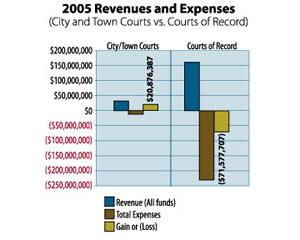 The Special Courts Committee has been tasked with studying Indiana’s court structure and trying to develop ways to make the system less cumbersome and more efficient. We have presented our preliminary findings at the spring district meetings and are continuing to seek your input on this project.
The Special Courts Committee has been tasked with studying Indiana’s court structure and trying to develop ways to make the system less cumbersome and more efficient. We have presented our preliminary findings at the spring district meetings and are continuing to seek your input on this project.
The evolution of Indiana’s court system is very intriguing. A timeline of significant changes is provided below to help demonstrate how frequently our system has been altered, one piece at a time. This piecemeal approach has created one of the most complex and fragmented systems in the United States.
Over the years, there have been a number of proposals to unify Indiana trial courts. In 1978 and 1986, the Indiana Judges Association recommended a unified court system along with state funding. Senate Bill 12 (recommended by the Commission on Courts in 1989) and House Bill 1103 (introduced in 2002) also called for unification and state funding.
The concepts of unification and state funding of the judicial system are even more relevant today. As referenced in Chief Justice Shepard’s Brennan Lecture at New York University School of Law in February 2006, the trend among state judicial systems is toward unification and state funding. In addition, at the Conference of Chief Justices and State Court Administrators in July 2006, Gov. Daniels noted his support for a unified court system and its resulting efficiencies. Today, the discussion about restructuring and streamlining Indiana’s court system continues.

The Committee believes that judicial development of the court structure pursuant to an overall strategic plan is important as opposed to a piecemeal approach. In developing this strategic plan, the judiciary can decide its own future rather than having a plan imposed on us. The Committee agrees that such efforts need to be based upon a consensus of the judiciary to develop a viable proposal. The goal of this project is to develop a structure that will allow autonomy by maintaining decision making within a district. As a result of several meetings, the Special Courts Committee is seeking input on the following concepts:
- All judges in Indiana being required to be law-trained,
- Unification of the trial courts,
- Establishment of districts,
- Merger of limited jurisdiction courts into the trial court system, and
- Judicial development of court structure pursuant to an overall strategic plan rather than piecemeal approach subject to legislative approval.
 The Committee, during its study, has been reviewing information on the potential fiscal and caseload impact of restructuring. This information is compiled based on data contained in the 2005 Judicial Services Report. The first chart compares the overall revenues and expenses of the city and town courts with the courts of record. The second chart illustrates the percentage of overall revenue contributed by the various courts. The final chart looks at revenues and expenses associated with each minute of judicial time. Generally, this information provides a good starting point for examining these issues, keeping in mind that the specific impact will vary among different jurisdictions.
The Committee, during its study, has been reviewing information on the potential fiscal and caseload impact of restructuring. This information is compiled based on data contained in the 2005 Judicial Services Report. The first chart compares the overall revenues and expenses of the city and town courts with the courts of record. The second chart illustrates the percentage of overall revenue contributed by the various courts. The final chart looks at revenues and expenses associated with each minute of judicial time. Generally, this information provides a good starting point for examining these issues, keeping in mind that the specific impact will vary among different jurisdictions.
At this point in the discussions, the Committee has identified a number of benefits to unifying the trial court system. These benefits include:
- Improves the public perception of the system and would be easier for citizens to use and understand,
- More efficient and economic use of judicial resources,
- Promotes local cooperation,
- Allow for the combining of resources to achieve economies of scale (jail overcrowding, juvenile placements), and
- Eliminate gaps in jurisdiction and afford citizens more certainty in the process.
 The overriding question has been – how does this affect me? The Committee believes that any proposal should continue to give local courts autonomy in designing the local organization to meet local needs (i.e. case allocation), and oversight of administrative issues, such as court employee matters. For some courts there would not be any changes (i.e. single court counties; existing unified court systems), while others would be undertaking more complex restructuring efforts (i.e. counties with multiple trial courts and municipal courts).
The overriding question has been – how does this affect me? The Committee believes that any proposal should continue to give local courts autonomy in designing the local organization to meet local needs (i.e. case allocation), and oversight of administrative issues, such as court employee matters. For some courts there would not be any changes (i.e. single court counties; existing unified court systems), while others would be undertaking more complex restructuring efforts (i.e. counties with multiple trial courts and municipal courts).
In developing our own structure, judges have the unique opportunity to design a system that will meet our collective goals and better serve our citizens. Your input, suggestions, and concerns are needed to help create a viable proposal. Please provide your feedback to:
Thank you in advance for your time and feedback on this project.